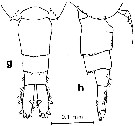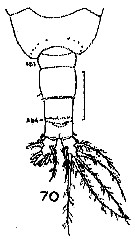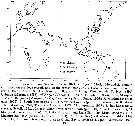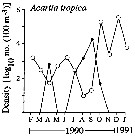|
|
 |
Fiche d'espèce de Copépode |
|
|
Calanoida ( Ordre ) |
|
|
|
Diaptomoidea ( Superfamille ) |
|
|
|
Acartiidae ( Famille ) |
|
|
|
Acartia ( Genre ) |
|
|
|
Acanthacartia ( Sous-Genre ) |
|
|
| |
Acartia (Acanthacartia) tropica Ueda & Hiromi, 1987 (F,M) | |
| | | | | | | Syn.: | Acartia plumosa : Sewell, 1932 (p.395); 1934 (p.80); Wellershaus, 1969 (part., p.271, figs.70, 75, no 66, 67.); Abraham, 1970 (p.115, figs.1, 3); Tranter & Abraham, 1971 (p.224, figs.2 Af, 2 Bf). | | | | Ref.: | | | Ueda & Hiromi, 1987 (p.233, figs.F,M). |  issued from : H. Ueda & J. Hiromi in Crustaceana, 1987, 53 (3). [p.227, Fig.2, g-h]. Female (from Chao Praya River mouth, Thailand): g, h, posterior metasome and urosome (dorsal and lateral, respectively). Nota: Armature on posterior corner of metasome similar to that of A. sinjiansis, but spines at ventralmost locus nearly as large as those at dorsalmost locus; each locus with 0-3 (usually 1 or 2) spines. Genital segment with 9-18 spines on posterodorsal margin; these spines not grouped at loci but evenly distributed; ventral surface with sevral rows of very minute hair-like spinules. 2nd urosomal segment with 6-10 posterodorsal spines; medial 2 spines larger than lateral ones and larger than spines on genital segment. Urosomal segment 3 with ventrolateral hairs. Caudal rami Length/width 1.9-2.2. A1 with 1 rowof spinules on each ventral surface of 9th to 12th segments.
|
 issued from: H. Ueda & J. Hiromi in Crustaceana, 1987, 53 (3). [p.228, Fig.3, c, e, h]. Female: c, forehead (ventral); e, right A1 (8th-13th segments, ventral view); h, P5 (ventral view).
|
 issued from : H. Ueda & J. Hiromi in Crustaceana, 1987, 53 (3). [p.229, Fig.4, f-g]. Male: f, g, urosome (dorsal and lateral, respectively). Nota: Urosomal segment 2 with 11-12 spines on posterodorsal and posterolateral margins; lateral spines not smaller than dorsal ones; ventral surface with spines at 2 loci on each side, each locus with 1-3 spines. 3rd and 4th urosomal segments with 4-8 and 4-6 posterodorsal spines, respectively (sometimes 4 loci can be distinguished on both segments); these spines usually larger than those on 2rd urosomal segment. Anal segment with ventrolateral hairs. Caudal rami Length/width 1.1-1.3.
|
 issued from : H. Ueda & J. Hiromi in Crustaceana, 1987, 53 (3). [p.231, Fig.5, d]. Male: d, P5 (anterior view).
|
 issued from : H. Ueda & J. Hiromi in Crustaceana, 1987, 53 (3). [p.235, Table I]. Comparative list of characters in the Acartia plumosa - sinjiensis - tropica species group.
|
 Issued from : S. Wellershaus in Veröf. Inst. Meeresf. Bremerhaven, 1969, XI. [p. 271, Fig. 70]. As Acartia (Acanthacartia) plumosa after Ueda & Hiromi, 1987. Female (from Cochin Backwater, area between outlet and Aroor Bridge): 70, last thoracic segment and urosome (dorsal). Nota: - Anal operculum without spines. - Caudal rami length : breadth = 10 : 6. - Eye of both sexes generally rd, pink or blue, sometimes colourless.
| | | | | Ref. compl.: | | | Ramaiah & al., 1996 (p.1); Ramaiah & Nair, 1997 (tab.1); Achuthankutty & al., 1998 (p.1, Table 2, fig.5, seasonal abundance vs monsoon); Madhu & al., 2007 (p.54, Table 4, abundance vs monsoon). | | | | NZ: | 1 | | |
|
Carte de distribution de Acartia (Acanthacartia) tropica par zones géographiques
|
| | | | | |  Carte de 1996 Carte de 1996 | |
 issued from : H. Ueda & J. Hiromi in Crustaceana, 1987, 53 (3). [p.232, Fig.6]. issued from : H. Ueda & J. Hiromi in Crustaceana, 1987, 53 (3). [p.232, Fig.6].
Distribution of the three species A. plumos, A. sinjiensis, A. topica. |
 issued from : C.T. Achuthankutty, N. Ramaiah & G. Padmavati in Pelagic biogeography ICoPB II. Proc. 2nd Intern. Conf. Final report of SCOR/IOC working group 93, 9-14 July 1995. Workshop Report No. 142, Unesco, 1998. [p.8, Fig.6]. issued from : C.T. Achuthankutty, N. Ramaiah & G. Padmavati in Pelagic biogeography ICoPB II. Proc. 2nd Intern. Conf. Final report of SCOR/IOC working group 93, 9-14 July 1995. Workshop Report No. 142, Unesco, 1998. [p.8, Fig.6].
Salinity ranges for A. tropica in coastal and estuarine waters of Goa (India).
Shaded area indicates the range of higher abundance. |
 issued from : C.T. Achuthankutty, N. Ramaiah & G. Padmavati in Pelagic biogeography ICoPB II. Proc. 2nd Intern. Conf. Final report of SCOR/IOC working group 93, 9-14 July 1995. Workshop Report No. 142, Unesco, 1998. [p.6, Fig.5]. issued from : C.T. Achuthankutty, N. Ramaiah & G. Padmavati in Pelagic biogeography ICoPB II. Proc. 2nd Intern. Conf. Final report of SCOR/IOC working group 93, 9-14 July 1995. Workshop Report No. 142, Unesco, 1998. [p.6, Fig.5].
Monthly occurrence of Acartia tropica in coastal (black circle) in front of Goa and and the Mandovi estuary (clear circle). |
| | | | Loc: | | | India (Cochin, Kerala, Bombay, Goa, Burhabalanga estuary, Salt Lakes, Bay of Bengal, Chao Praya River mouth (Thailand) | | | | N: | 9 | | | | Lg.: | | | (93) F: 1,04-0,93; M: 0,88-0,83; {F: 0,93-1,04; M: 0,83-0,88} | | | | Rem.: | saumâtre.
Voir aussi les remarques en anglais | | | Dernière mise à jour : 22/07/2019 | |
|
|
 Toute utilisation de ce site pour une publication sera mentionnée avec la référence suivante : Toute utilisation de ce site pour une publication sera mentionnée avec la référence suivante :
Razouls C., Desreumaux N., Kouwenberg J. et de Bovée F., 2005-2025. - Biodiversité des Copépodes planctoniques marins (morphologie, répartition géographique et données biologiques). Sorbonne Université, CNRS. Disponible sur http://copepodes.obs-banyuls.fr [Accédé le 25 décembre 2025] © copyright 2005-2025 Sorbonne Université, CNRS
|
|
 |
 |











